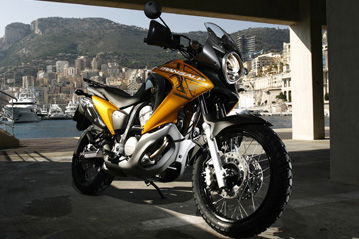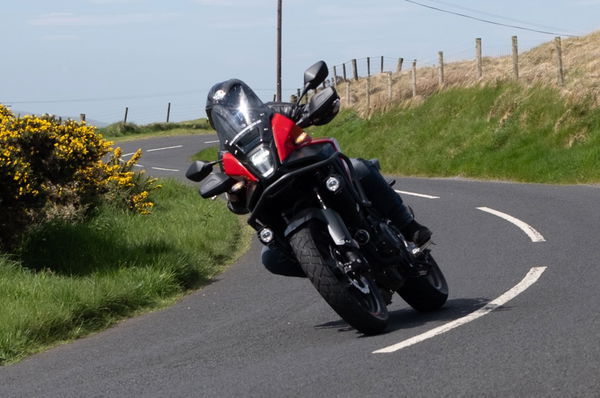First Ride: Honda XL700 Transalp
Older than the hills themselves, Honda’s original Adventure bike just got itself a total makeover for 2008. And a whole new lease of life...

 |
Adventure Sports bikes are currently the fastest-growing market sector in motorcycling in Britain today. At 31% up on last year they are flicking two long-suspended fingers up at superbikes, who by comparison are only a measely 4% up year-on-year. It would appear that UK riders are finally following in the footsteps of our European chums, eschewing one million bhp in favour of decent tank ranges, Ewan and Charlie styling and easier everyday riding. It had to happen at some stage. As motorcycling becomes older and fewer young bloods come in at the bottom, so biking’s demographic has changed. And in the same way the dinosaurs eventually gave way to warm-blooded furry little mammals, it would appear that the Adventure Sports bikes are stepping forward to inherit the earth.
And into this odd-looking world comes a new Honda Transalp. I remember these things from back in 1987 when I was a mere nipper. They were white and blue and nobody was quite sure what to do with them, so they took them off-road. Which the Transalp wasn’t really meant to do (to any great degree) so at the time it was dubbed either a silly roadbike or a rubbish dirtbike. More recently, I rode 1,600 miles around Turkey for the last issue on a 650 Transalp, which probably makes me the only journalist to have actually ridden one in the last 10 years and therefore uniquely qualified to comment on the new bike. And while that Transalp was brilliant at pottering around the country at 80mph in tremendous comfort, it was wholly unexciting and not very pretty. I admired it for what it could do but always wished I was on something else.
And so to this latest incarnation. It’s been hogged out to 680cc, got completely new bodywork and a smaller, more road-orientated 19” front wheel to make it handle better and offer a wider choice of tyres. Some of the journalists on the launch thought it was grossly ugly, and certainly the headlight assembly is no oil-painting. But I rather like its rumpy, stumpy Massey Ferguson looks, and the new Transalp has the air of a bike which can be ridden for miles and take a hell of a beating in the process. 20 years of refinement mean this Honda is nothing if not built to last, and I wager you could throw this fella down the road at least five times before you actually needed to fix anything more than brake levers.
Compared to the slightly lifeless 650 it replaces, the new bike’s performance is almost rampant in comparison. We did a lap of the Monaco F1 street circuit before heading North into the Alps, and the XL700 has got plenty of poke. Nothing like a Triumph Tiger or KTM Adventure, of course, and with only 60bhp on tap the Transalp is never going to pin your ears back under full boost, but there’s certainly enough oomph for something of this ilk and fun things like wheelies are easily achieved with a flick of the clutch lever. Honestly, the old model struggled to do even that. The exhaust note thuds along pleasingly behind you, the midrange power is surprisingly plump, and gauged purely on the merits of its engine the new Transalp is a big step forward. 100mph comes up on the easy-to-read instruments very easily, and you get big-bike feel at the throttle for just another 30cc and a reworked cylinder head. The fastest I saw in a straight line, if you care about that sort of thing on a bike like this, was 130mph. Downhill and with a slight tailwind.
The Transap is incredibly easy to ride and extremely comfortable over distances long or short. It was bitterly cold in the South of France during the launch, and I was extremely thankful for the bike’s stubby but effective screen and deeply contoured sit to hunker down in out of the windblast. Heated handlebar grips would have been better (and are an official accessory along with a whole plethora of other useful add-ons) but then since Honda decided to put us up that night in flimsy Ikea tents in wafer-thin Ikea sleeping bags and leave us to our sleepless fate when it was -3 degrees outside, I suppose we had to be grateful for small mercies. Like effective windscreens and comfy seats. Unless you live in the South of France you always forget how utterly stunning the lower Alpine region is, and loping along at an easy pace the Transalp was a brilliant way of enjoying the scenery. The orange Autumn trees clashed with the snow on the ground and deep blue skies, and if you’d been there you’d have gotten all poetic, too.
Tragedy struck after lunch, however. Stopping to warm up in a fancy chateaux, I nipped into the local market square and spent a whole £15 on a kilo of super-stinky French cheese. Proper local produce from proper local farmers. Lobbed it into the Transalp’s topbox (very fiddly lock, made me swear out loud just getting it open each time) and took off for the next location. We were in the Alps proper now and you could feel the air thinning as we climbed ever higher, and at the next photo-stop I turned the Transalp off-road and went for a blaze through some high mountain meadows. The XL was surprisingly agile (the tyres don’t do very much if it’s remotely damp, mind) and we jumped, slid and bunny-hopped our way over the grass at high velocity. And then I remembered my cheese. My worst fears were confirmed when I finally got the topbox open and my glorious stinking fromage was spread all over the interior. Still, serves the bloody things right for being so bloody hard to open.
It’s always amazing how altitude starves an engine of oxygen and therefore power. By the time we reached the peak of the Col de la Bonette, at 8,900ft the highest driveable pass in the Alps, the Transalp had lost all the eagerness it had displayed down in Monaco. It still puffled along okay, but now felt more like the old bike and wheelies were an almighty struggle. The journalists to whom wheelies meant everything had to follow the photographer back down the mountain to get their shots. Transalp and me carried on alone, cooing at the views and enjoying the ever-twisty roads.
The handling is very good indeed for a bike of this nature, no complaints in this department at all. The Transalp is tall enough that dirt roads and potholes simply aren’t an issue, while being short enough that you don’t need a winch just to get on the thing and the handling isn’t top-heavy or compromised because of it. No high-speed weave that I detected, fairly composed in fast corners, if you really want to pick holes the suspension is fairly budget in its feel and there’s not much in the way of feeling from the front end, but then I learned the price of the Transalp and all potential complaints faded away.
£5,399 on the road. Bloody hell, that’s proper cheap. Bit of wrangling and haggling with the right dealer and chances are you’ll get that figure below the five grand mark, putting the Transalp in direct competition with bikes like Kawasaki’s odd-ball Versys. It never ceases to amaze me how much bike you get for your money these days, and while any owners of old Transalps should immediately upgrade to this new version, plenty of other riders who are looking at the Adventure Sports category now have a new option to investigate. It’s a Honda, so it’ll run forever and since it’s got 20 years of refinement behind it nothing will fall off, either. For just 60% of the price of a KTM Adventure (undoubtedly the masterpiece in this category) you get a bike with 80% of its performance. The Transalp will never set your pants on fire with lust or envy, but this latest version will thud dependably over the horizon for at least another 10 years.
SPECS:
Price: £5,399
Engine: 680cc, liquid-cooled,
SOHC, 8-valve 52_ V-twin
Power: 60bhp@ 7,700rpm
Torque: 44lb.ft@ 5,500rpm
Front suspension: 44mm forks, non adjustable, 177mm travel
Rear suspension: Monoshock, adj. comp. damping, 173mm travel
Front brake: 256mm discs, three-piston calipers
Rear brake: 240mm disc
Seat height: 850mm
Fuel capacity: 17.5 litres
Top speed: 128mph (est)
Dry weight: 214kg
Colours: Yellow, Red, Grey or Blue











